1. Language and programming language
1-1. Language
- A tool to communicate among humam beings
- First written language : Sumerian
- Programming language
: A tool for communication between literal-minded machines
: A protocol among users to control computers
1-2. Definition of formal language
- Is a set of finite strings of atomic symbols from alphabet where alphabet is defined as a set of given symbols
1-3. Why we learn programming languages?
- To implement more effective algorithms by learning features, understanding implementations, increasing vocabulary such as Recursion, and Memory management mechanisms
- To choose better programming languages by comparing various languages for the purpose
- To learn new foreign languages more quickly and easily
(Languages in general have similar structures and components) - To develop better programming languages
for better user interfaces and functions
1-4. Attributes of a Good Language?
- Orthogonality
-- Ability to combind various features of a language - Support for abstraction
-- Construct to factor out reoccurring patterns - Natural for various applications
-- For business, mathematics, science, game, etc - Easy of program verification and debugging
-- Formal verification & desk checking - Portability and Translation
-- Minimum degree of computation and space complexity
-- Considering various architecture
1-5. Classification of the Languages
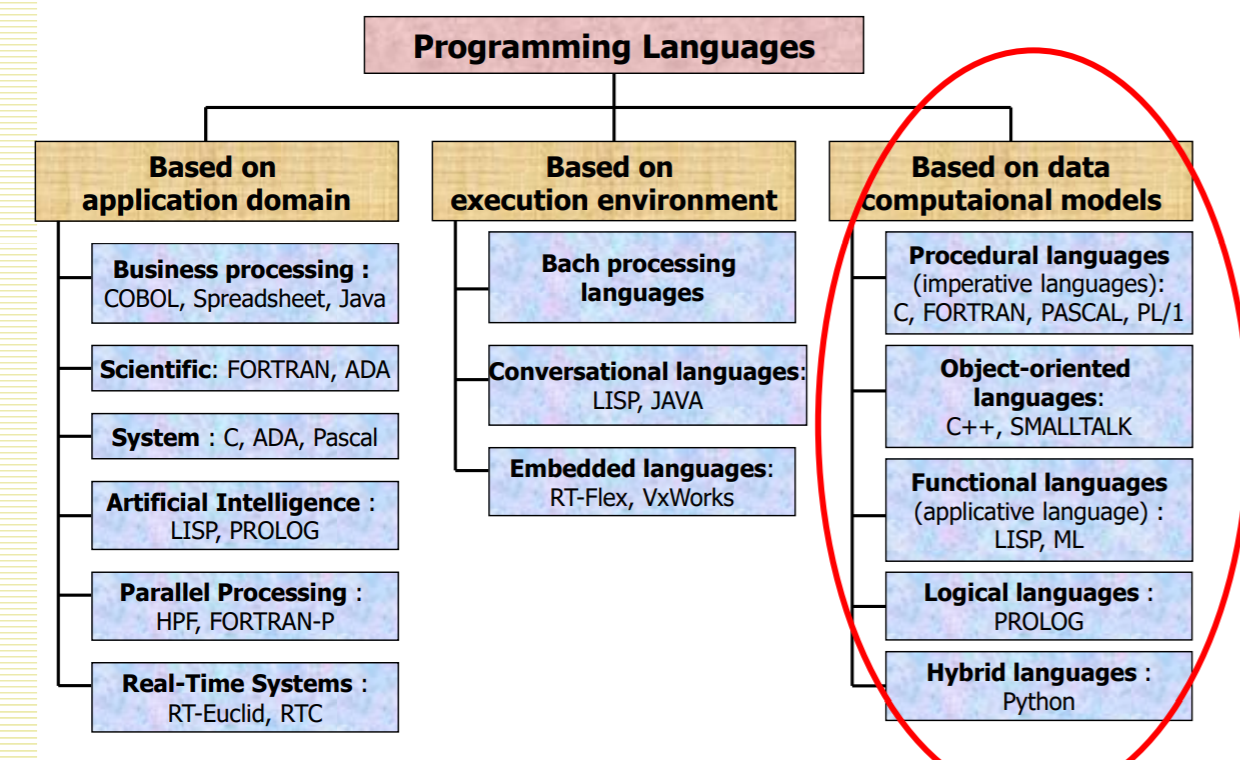
1-6. Models of Programming Languages
-
Imperative Languages(Command Driven Language)
-- A program consists of a sequence of statement
-- Execution of each statements causes interpreter to change the state of the system
-- Successive machine states lead to the desired solution
-- C, Fortran, Algol, PL/I, PASCAL -
Object Based Languages
-- Complex objects are designed as extensions of simpler objects
-- Inheriting of simple objects
-- C++, Java, Small talk
-- Gain the efficiency of imperative languages
-- Gain the flexibility and reliability of applicative languages -
Applicative Languages(Functional Language)
--Perform a function with its arguments to generates results
-- Results of a function can be arguments of another function
-- LISP and ML -
Rule-based Languages (Logical Languages)
-- Execute an action when a certain enabling condition(predicate) is satisfied
-- Building a matrix or table of possible conditions and appropriate actions for proofs or database search
-- Program consists of fact, rule, and query
-- Prolog
ex) dog(john).
cat(marry).
monkey(james).
friendly(john, james) -
Hybrid Languages: Python
2. Machine Architecture and Language
2-1. Von Neumann Computer Architecture
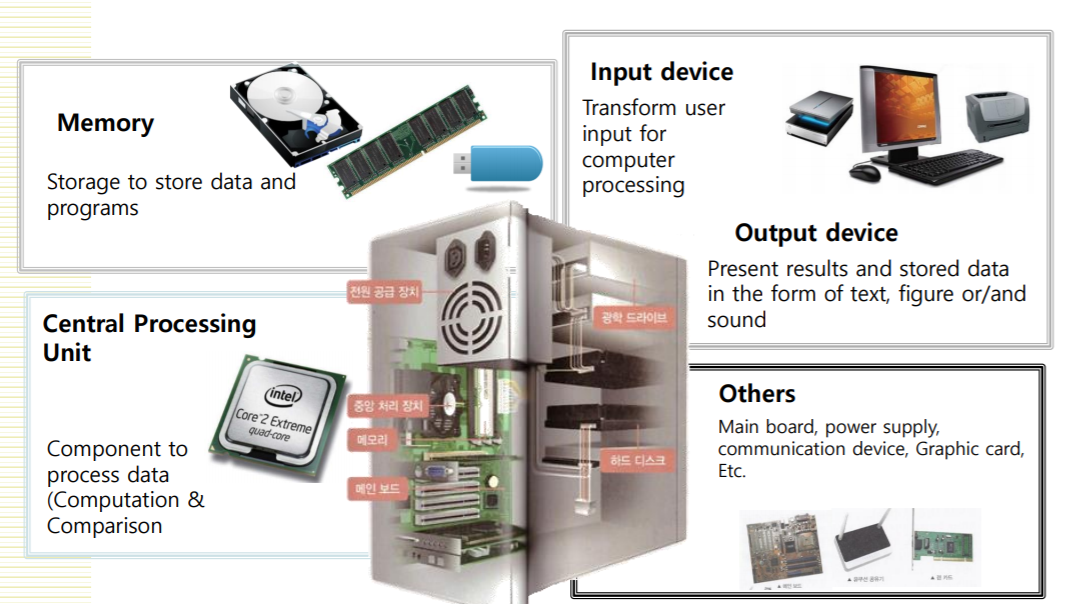
2-2. Conventional Computer Organization
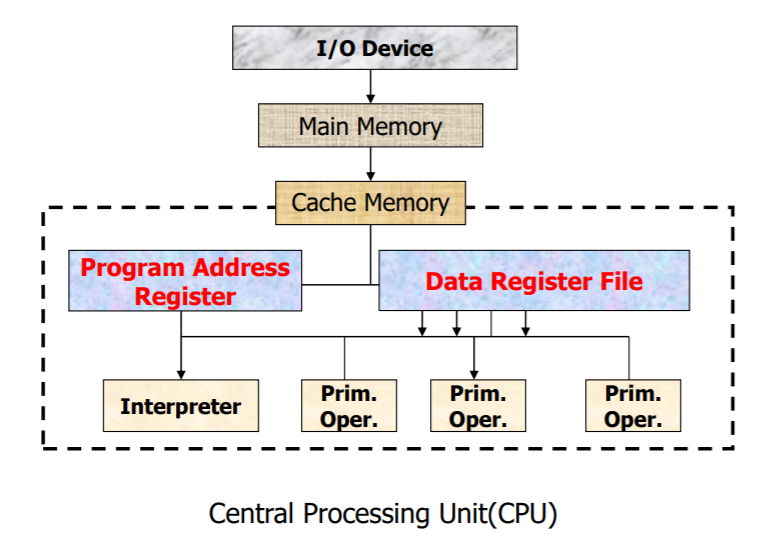
2-3. Computer Architecture and Language Related Issues
: Major components of a computer that correspond to the six major aspects of programming languages
- Data
-- Elementary data types and structured data
-- Storages are high speed registers, main memory, and external files
-- Built-in data vs. user-defined data - Operations
-- Set of operations to manipulate the data
-- Arithmentic operations, testing, accessing, modifying operation
-- Device control operation
-- Sequence control operation - Sequence Control
-- Mechanisms to control the instruction sequence
-- Use of program address register(PAR) to indicate next instruction
-- Branch operations are used to control sequences
-- Instruction level sequence control
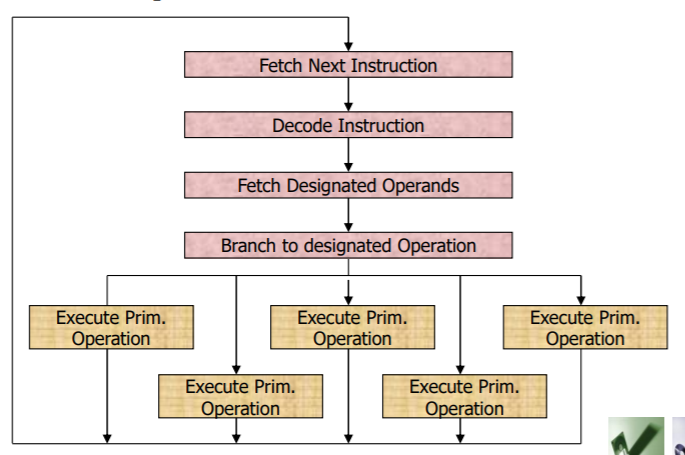
- Data Access
-- Mechanism to access and control the data
-- Serial access vs. parallel access - Storage management
-- Mechanism to control the storage of data and instructions
-- Imbalance due to access time, memory, and register : Buffered write uesed - Operational environment
-- Mechanisms for communication with external devices
-- I/O devices (CD-ROM, Tapes, Modems ...) - Other Factors
-- System Architecture
-- Von Neumann vs. Multiprocessor system
-- RISC, SIMD, MIMD, SPMD
3. Syntax Analysis and Semantics
3-1. Syntax
- Grammar : <T, N, P, S>
-- Terminal: A finite set of terminals
-- Nonterminal: A finite set of non-terminals not in T
-- Production: A finite set of production(rewriting) rules
-- Start Symbol: An element of N the distinguished starting non-terminal - Notations
-- BNF (Backus-Naur Form)
4. Compilation Language & Compilation Process
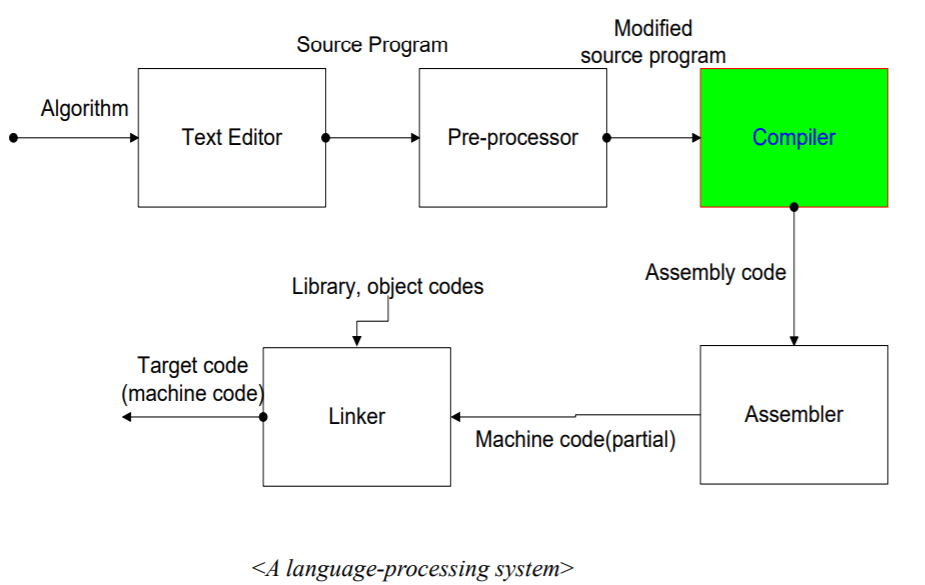
5. Compiler and translation related issues
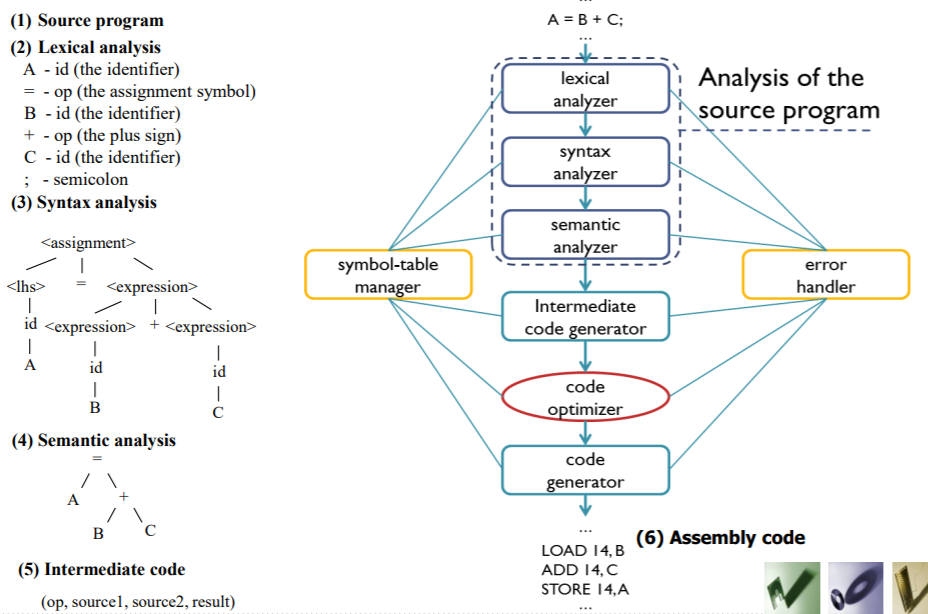
6. Language Design Issues
6-1. Binding Times
: Time to choose the properties or characteristic for programming elements
- Language definition time
- Language implementation time
- Program translation time by
: Programmer
: Translator
: Loader - Program execution time
6-2. Language Classification by translation method
- Compilation languages vs. Interpretation languages
7. Chomsky Hierarchy
7-1. Concept
: Formal Basis for describing the artificial language that we use to program computers
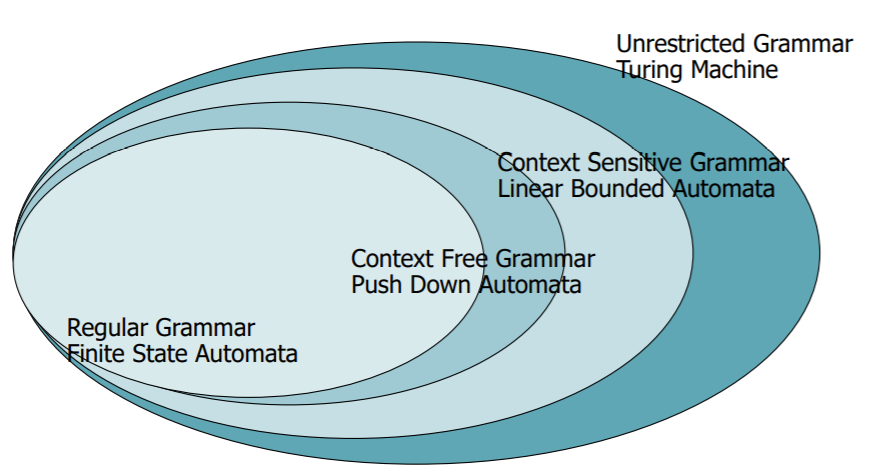
7-2. Type 0: Unrestricted Grammar
-
Type 0: Undestricted Grammar
-- α->ß : No restrictions applied
-- TM is also called recursively enumerable language since the elements can be listed and hopelessly inefficient
-- Recognized by Turing Machine (infinite r/w type) -
Process of Turing Machine
-- Language recognizer is a procedure for definig a set of strings
-- advance to next state, write back onto the current position, change the direction to move
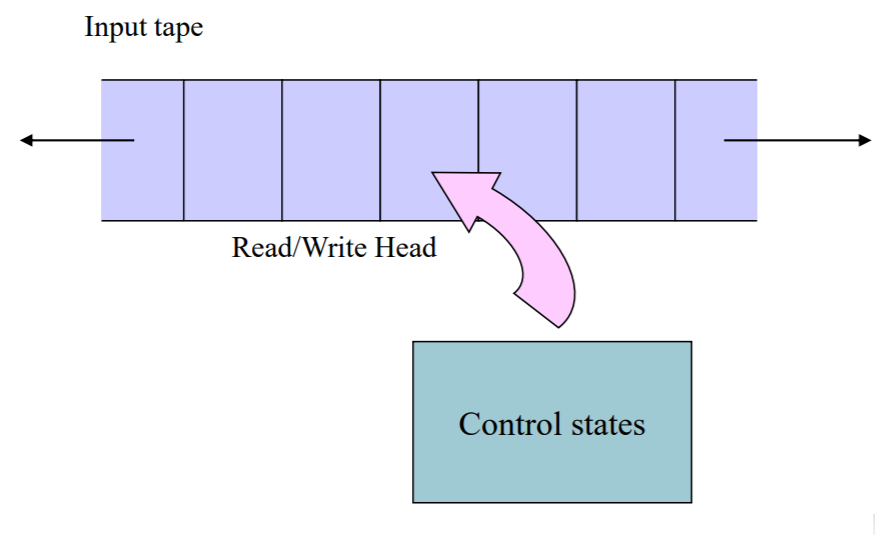
7-3. Type 1: Context Sensitive Grammar
- Type 1: Context Sensitive Grammar
-- α->ß where |ß| > |α| except S->ε
-- LHS of each production must have at least one non-terminal
-- Say A becomes ß in the context of α1 and α2
-- Too complex for a specification of computer languages
-- Recognized by Linear Bounded Atomaton (LBA)
7-4. Type 2: Context Free Grammar
-
Type 2: Context Free Grammar
-- A->ß where A is a variable and ß is a string from (∑ U N)*
-- The derivations are invoked independent of what surrounds them
-- Exactly a single non-terminal on LHS of each production
-- Does not allow empty production except the single production with a start symbol
-- Recognized by Push Down Automaton (PDA)
: pops a symbol from the stack
: push the same or other symbols into the stack
: optionally read or advance its input tape
-
Process of Pushdown Automata

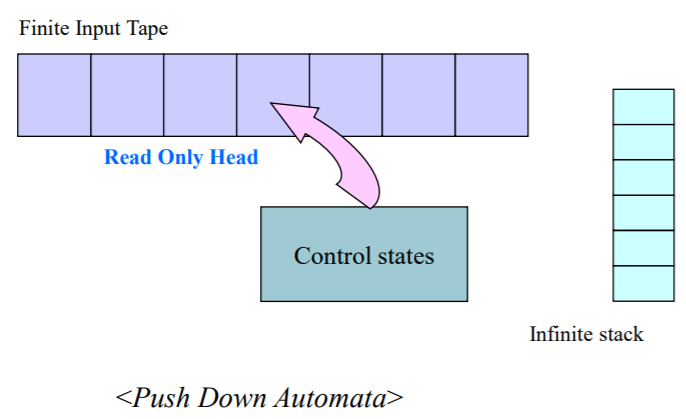
-
Limits of Context Free Grammar
-- Modern programming languages are specified with CFG but expanded to CSG with attributes
-- Count comparison can be done by CFG, but cannot match the same words
-- But, cannot write CFG to match the spelling of the same word twice like abcabc7-5. Type 3: Regular Grammar
-
Type 3: Regular Grammar
-- A -> wB or A -> w right linear
-- Allow one non-terminal on LHS and one or two symbols on RHS with the first be terminal symbol
-- Too restrictive for most purpose; however, very efficient recognizer can be built
-- Incapable of generating language structures like arbitrary deep nested parenthesis
-- Does not allow empty production except the single production with a start symbol
-- Recognized by Finite State Automaton -
Process of Finite State Automata
-- Empty production vs. Empty language
-- A language that generates empty string
-- A language that generates no string
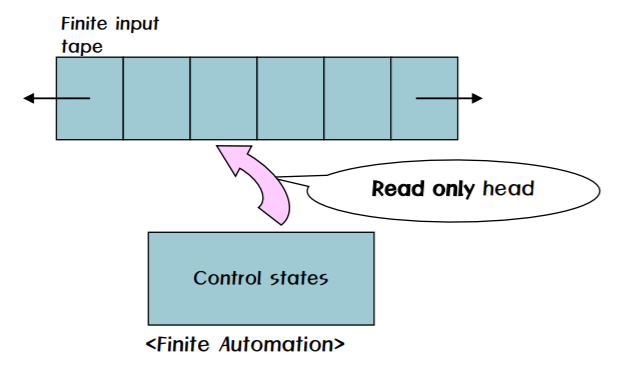
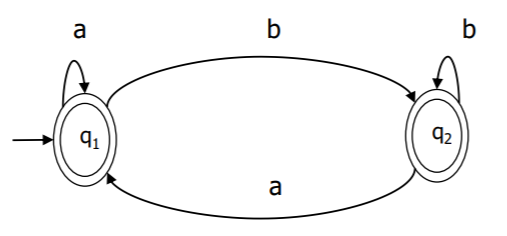

Michael had always been drawn to the thrill of high-stakes games, searching for that next big rush to get his heart racing. When he discovered an https://q7casino1.com/ online blackjack site that boasted exciting gameplay and the potential for enormous jackpots, he was immediately hooked. The site promised an adrenaline-pumping experience, and Michael was eager to dive in. He deposited a significant amount of money, ready for whatever the night had in store.